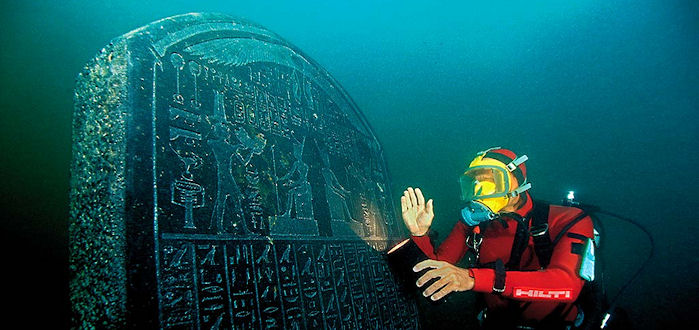According to surviving ancient texts, the city of Herakleion, once sitting at the area of the Nile delta and later disappeared undersea, used to be the main port entrance to Egypt before Alexandria was founded in the year 331 BC.
The underwater ruins of this city have been discovered in the bay of Abukir by the research team of Franck Goddio with the cooperation of Egypt’s Supreme Council for Antiquities.
The recent findings are concentrated in an area 1,000 m long and 800 m wide and vary from small everyday pottery items to significant buildings remains and harbor installations. One of the most valuable items recovered is a fully intact black granite column that seems to be very much similar to the Stela of Naukratis (Cairo Museum). That was discovered in 1899 and is dated to the rule of Pharaoh Nektanebos the First (378-362 BC), the first Pharaoh of the thirtieth dynasty. This last Egyptian dynasty was replaced by the Ptolemaic line. The simple fact of the existance of two almost identical columns (stelai, plural for the Greek stela, meaning column) is quite intriguing since it is regarded as unique in the history of Egyptology.
The harbor position is established with great accuracy since it is pointed by more than 10 ship wrecks. Other important findings are 3 statues of pink granite near what seems to be a very thick wall segment. This is believed to be the site of the main temple of the city. Further excavations in the temple area produced numerous artifacts. Bronze vessels, gold coins and jewellery were found in very well-preserved condition, together with several statues of excellent quality. None of the objects retrieved from the site is dated later than the first century before Christ. The general state of the findings indicate that the city was stricken by an earthquake and probably the resulting wave.
Besides its obvious archeological value, the discovery is believed to produce serious information concerning the accuracy of historic and pro-historic events that the city is implicated in. To begin with the city is reported by Diodorus to be one of the places where Hercules performed one of his athlus by saving the city from one of Nile's flooding after the collapsing of the city's dykes. From this visit the city gains its name, "Herakleion"
Herodotus establishes Herakleion as the first stop of the beautiful Helena and her lover Paris, after their flee from Helena's husband Menelaus. However the locals, afraid of the rage of the Greeks, did not allow the couple to remain there. Then the couple seeks shelter to Paris's hometown, Troy and one of the greatest ancient conflicts is about to begin.
Concluding, the discovery of Herakleion is of the outmost importance, since besides bringing to light a very important archeological treasure it is believed that, as the research expeditions will continue, valuable information may be found concerning the history of an important city and subsequently add to our knowledge of ancient Egypt and the other civilizations of the area.




